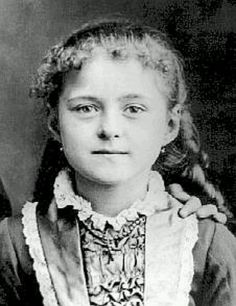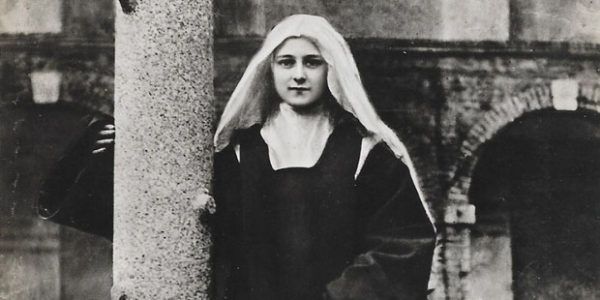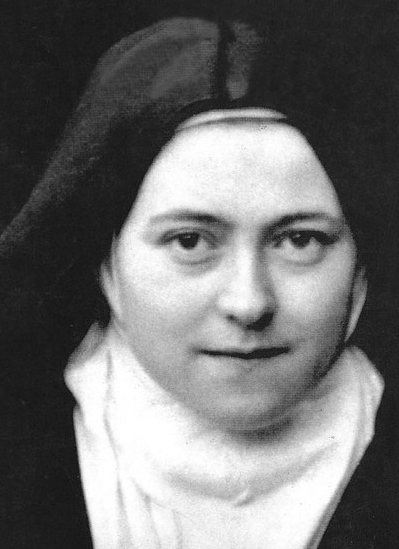Happy October 1 – Feast Day of Thérèse of Lisieux!
Thérèse of Lisieux (1873-1897) was a French Discalced Carmelite nun, who is sometimes referred to as “the little flower.” She entered the Carmelite monastery in Lisieux at the age of 15 and cultivated a spirituality of littleness. This humility can be seen in her prayers, poems and spiritual writings that together comprise a spiritual approach often called “the little way.” She was beatified in 1923, canonized in 1925 and proclaimed a Doctor of the Church by Pope John Paul II in 1997.
Thérèse of Lisieux was born Marie Francoise-Thérèse Martin in Alencon, France in 1873. Her father was a jeweler and a watchmaker, and her mother was a skillful lacemaker. Thérèse was a frail child who was raised in a strict Catholic family, attending daily Mass, participating in prayer and fasting, and enveloped by an environment that followed the rhythm of the liturgical calendar. Her mother died in 1877, when Thérèse was only 4 years old. Her father sold the lacemaking business and moved his 5 daughters to Lisieux, near Normandy.
 Due to her mother’s death, Thérèse became very close to her older sisters Marie, Pauline, Leonie, and Céline. She was educated at home until she was eight years old and then was sent to school, where it was said that she was bullied because of her high grades. As a seriously religious child, she was inspired by stories of the great Carmelite Teresa of Avila, and would play at being an anchorite with her cousin Marie Guerin. In 1882, her sister Pauline, who had been like a second mother to her, entered the Carmelite monastery at Lisieux. Thérèse was devastated because she knew that Pauline had forsaken the secular world to be cloistered and could not come home to visit. Thérèse also wanted to become a nun, but was told that she was too young. She began to experience nervous tremors, but recovered completely after she gazed at a statue of Mary and saw the Virgin smile at her. In 1886, her sister Marie also entered the convent at Lisieux, and Thérèse began suffering from scruples. Scruples is a type of pathological guilt experienced around moral and/or religious issues. It can be very distressing, obsessive, and dysfunctional, at times leading to difficulties in social interactions.
Due to her mother’s death, Thérèse became very close to her older sisters Marie, Pauline, Leonie, and Céline. She was educated at home until she was eight years old and then was sent to school, where it was said that she was bullied because of her high grades. As a seriously religious child, she was inspired by stories of the great Carmelite Teresa of Avila, and would play at being an anchorite with her cousin Marie Guerin. In 1882, her sister Pauline, who had been like a second mother to her, entered the Carmelite monastery at Lisieux. Thérèse was devastated because she knew that Pauline had forsaken the secular world to be cloistered and could not come home to visit. Thérèse also wanted to become a nun, but was told that she was too young. She began to experience nervous tremors, but recovered completely after she gazed at a statue of Mary and saw the Virgin smile at her. In 1886, her sister Marie also entered the convent at Lisieux, and Thérèse began suffering from scruples. Scruples is a type of pathological guilt experienced around moral and/or religious issues. It can be very distressing, obsessive, and dysfunctional, at times leading to difficulties in social interactions.
Just 13 years old, Thérèse reached a turning point in her life, when she had what she called a “complete conversion” on Christmas Eve 1886. As she was opening her Christmas gifts, Thérèse later wrote that she instantly “recovered the strength of soul” she had lost when her mother died. She became stronger and less sensitive and weepy, which she may have experienced as a kind of liberation. Through this moment of grace, Thérèse’s character as a saint began to be born.
In May 1887, Thérèse approached her father Louis, who was recovering from a mild stroke, about entering the convent. They both cried, and then her father picked a small white flower, root intact, and gave it to her, explaining that God had cared for it especially for her until just that day. Thérèse saw the flower as a symbol of herself “destined to live in another soil.” Because of this story, Thérèse is often referred to today as “the little flower.”
In November of the same year, Louis took his daughters Céline and Thérèse on a pilgrimage to Rome, in order to participate in the celebration of the jubilee of Pope Leo XIII. During a general audience, Thérèse asked the Pope to allow her to enter the Carmelite religious order at the age of 15. The Pope said for her to let her superiors decide and told her that she could enter the convent if it was God’s will. An interesting footnote to this story is that she apparently refused to leave Pope Leo and the Swiss Guard had to carry her out of the room. The pilgrimage continued to Pompeii, Naples, Assisi, Pisa, and Genoa. Thérèse claimed that she learned more from that pilgrimage than she had in all of her previous studies.
 In April 1888, at the age of 15, Thérèse finally became a postulant and was welcomed to the Carmelite Monastery at Lisieux. She later wrote that as she received communion that day that she felt a “deep sweet peace which filled [her] soul.” Thérèse chose the Jesuit, Father Pichon, to be her spiritual director and she made a complete confession of her sins. She told him about the scruples she experienced, and because he had also suffered from scruples, he reassured her of her inherent goodness, and she came away from their meeting very relieved.
In April 1888, at the age of 15, Thérèse finally became a postulant and was welcomed to the Carmelite Monastery at Lisieux. She later wrote that as she received communion that day that she felt a “deep sweet peace which filled [her] soul.” Thérèse chose the Jesuit, Father Pichon, to be her spiritual director and she made a complete confession of her sins. She told him about the scruples she experienced, and because he had also suffered from scruples, he reassured her of her inherent goodness, and she came away from their meeting very relieved.
In January 1889, Thérèse’s postulancy was complete and she received the Carmelite habit, formally entering the convent as a novice. New Carmelites are given an epithet name, for example Elizabeth “of the Trinity.” This name is intended to be a special devotion to a nun over the course of her life. When Thérèse entered the convent she received the epithet “of the child Jesus” but later asked to be given a second epithet “of the Holy Face.” During her novitiate, she spent many hours in contemplation of the Holy Face of Jesus.
In February 1893, Pauline became the prioress of the convent and gave the work of guiding the new novices to Thérèse. In her teaching, she used the symbol of a kaleidoscope to represent the Holy Trinity – three mirrors that turn scraps of colored paper into a fantastic and wonderous beauty. In September of the same year, Thérèse finished her 3 years as a novice and asked to be allowed to remain a novice indefinitely. In this way, she would always have to ask permission for many small things from the nuns who had taken their final vows and so that she would always be in a position where she could not be elected to any role of importance.
One theme that Thérèse used in her writings was that of fire. The following excerpt from her poem “Living on Love” is what I have selected to include as her quote in the book I am putting together and this is the artwork that I made to go with it.

Living on Love is giving without limit
Without claiming any wages here below.
Ah! I give without counting, truly sure
That when one loves, one does not keep count!…
Overflowing with tenderness, I have given everything,
To His Divine Heart… lightly I run.
I have nothing left but my only wealth:
Living on Love.
Living on Love is banishing every fear,
Every memory of past faults.
I see no imprint of my sins.
In a moment, love has burned everything…
Divine Flame, O very sweet Blaze!
I make my home in your hearth.
In your fire I gladly sing:
“I live on Love!…”
Thérèse of Lisieux (1885)
Thérèse had a very simple and direct practicality in her approach to spirituality. She applied herself “especially to practice little virtues, not having the facility to perform great ones.” Thérèse often focused on the theme of littleness, referring to herself as a grain of sand “littler, lighter in order to be lifted more easily by the breeze of love.” She studied the writings of John of the Cross instead of those of Teresa of Avila, which was rather uncommon for spiritual reading at that time.
 Thérèse was also captivated by the new technological development of the elevator. She wrote “I will seek out a means of getting to Heaven by a little way – very short and very straight, a little way that is wholly new. We live in an age of inventions; nowadays the rich need not trouble to climb the stairs, they have lifts instead. Well, I mean to try and find a lift by which I may be raised unto God, for I am too tiny to climb the steep stairway of perfection.”
Thérèse was also captivated by the new technological development of the elevator. She wrote “I will seek out a means of getting to Heaven by a little way – very short and very straight, a little way that is wholly new. We live in an age of inventions; nowadays the rich need not trouble to climb the stairs, they have lifts instead. Well, I mean to try and find a lift by which I may be raised unto God, for I am too tiny to climb the steep stairway of perfection.”
In 1896, not long after the usual Lenten fast, Thérèse began coughing up blood and was diagnosed with tuberculosis. She suffered a great amount of physical pain, and in July 1897, she moved into the infirmary, where she died on September 30 at the age of 24. Her feast day is celebrated every year on October 1.
Reference 1: Kinney, Donald translator, “The Poetry of Saint Thérèse of Lisieux,” Washington Province of Discalced Carmelites, ICS Publications, Institute of Carmelite Studies, Washington DC, 1995.
Reference 2: http://www.archives-carmel-lisieux.fr/english/carmel/ (Official website for Carmel in Lisieux)
Image 1: Madame Besnier, photographer from Lisieux, 1881.
Image 2: Detail from photograph by Fr. Gombault, January 1889.
Image 3: “Thérèse of Lisieux,” Julie Henkener, 2018.
Imag 4: Detail from photograph by Céline Martin, April 15, 1895.















1 Comment
Leave your reply.